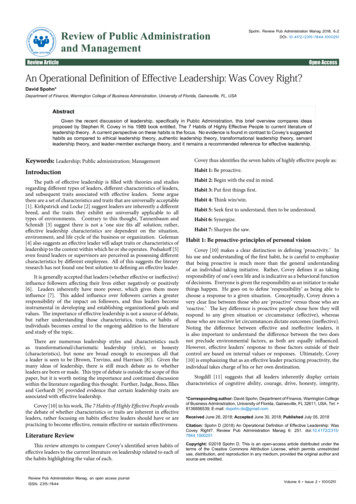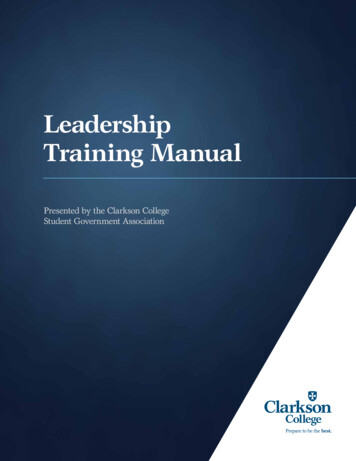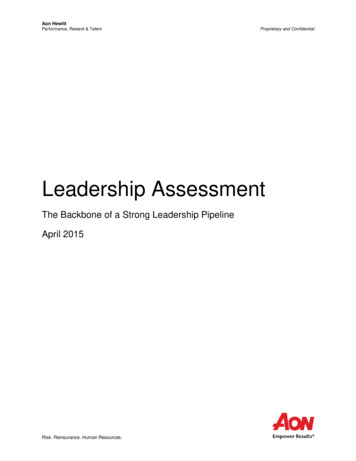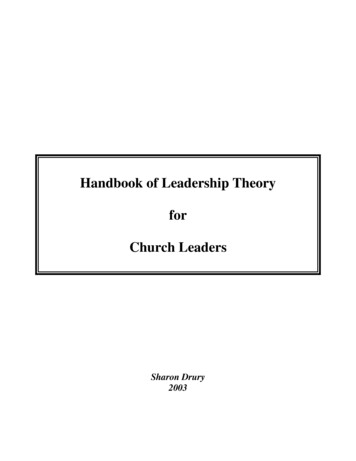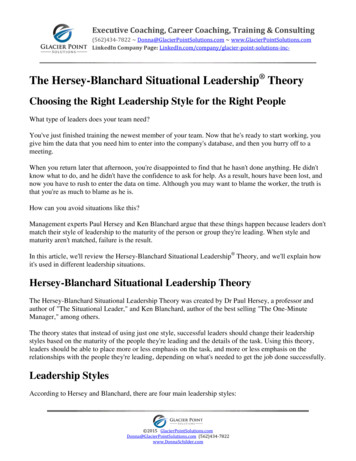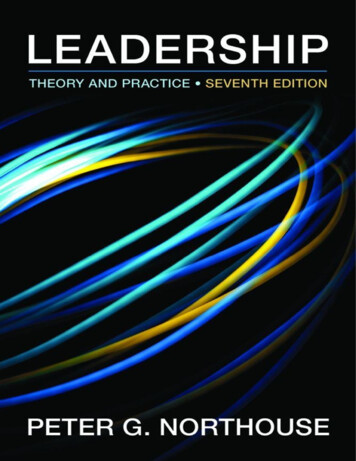
Transcription
LeadershipSeventh Edition
To Laurel, Lisa, Madison, Scott, and Kallie
LeadershipTheory and PracticeSeventh EditionPeter G. NorthouseWestern Michigan University
FOR INFORMATION:SAGE Publications, Inc.
2455 Teller RoadThousand Oaks, California 91320E-mail: order@sagepub.comSAGE Publications Ltd.1 Oliver’s Yard
55 City RoadLondon EC1Y 1SPUnited KingdomSAGE Publications India Pvt. Ltd.B 1/I 1 Mohan Cooperative Industrial Area Mathura Road, New Delhi 110 044IndiaSAGE Publications Asia-Pacific Pte. Ltd.
3 Church Street#10-04 Samsung HubSingapore 049483Copyright 2016 by SAGE Publications, Inc.All rights reserved. No part of this book may be reproduced or utilized in any formor by any means, electronic or mechanical, including photocopying, recording, orby any information storage and retrieval system, without permission in writingfrom the publisher.Printed in the United States of America Library of Congress Cataloging-in-Publication Data Northouse, PeterGuy.Leadershop : theory and practice/Peter Northouse, Western Michigan University.—Seventh Edition.pages cmIncludes bibliographical references and index.ISBN 978-1-4833-1753-3 (pbk. : alk. paper) 1. Leadership. 2. Leadership—Case studies. I. Title.HM1261.N67 2015303.3′4—dc232014044695This book is printed on acid-free paper.15 16 17 18 19 10 9 8 7 6 5 4 3 2 1Acquisitions Editor: Maggie Stanley Associate Editor: Abbie Rickard Editorial Assistant: Nicole MangonaProduction Editor: Libby Larson Copy Editor: Melinda Masson Typesetter: C&M Digitals (P) Ltd.Proofreader: Sally Jaskold Indexer: Sheila BodellCover Designer: Gail Buschman Marketing Manager: Liz Thornton Digital Content Editor: Katie Bierach
Detailed Contents
Detailed Contents1. Preface2. 1. Introduction1. Leadership Defined1. Ways of Conceptualizing Leadership2. Definition and Components2. Leadership Described1. Trait Versus Process Leadership2. Assigned Versus Emergent Leadership3. Leadership and Power4. Leadership and Coercion5. Leadership and Management3. Plan of the Book4. Summary5. References3. 2. Trait Approach1. Description1. Intelligence2. Self-Confidence3. Determination4. Integrity5. Sociability6. Five-Factor Personality Model and Leadership7. Emotional Intelligence2. How Does the Trait Approach Work?3. Strengths4. Criticisms5. Application6. Case Studies1. Case 2.1 Choosing a New Director of Research2. Case 2.2 A Remarkable Turnaround3. Case 2.3 Recruiting for the Bank7. Leadership Instrument1. Leadership Trait Questionnaire (LTQ)8. Summary9. References4. 3. Skills Approach
1. Description1. Three-Skill Approach1. Technical Skill2. Human Skill3. Conceptual Skill4. Summary of the Three-Skill Approach2. Skills Model1. Competencies2. Individual Attributes3. Leadership Outcomes4. Career Experiences5. Environmental Influences6. Summary of the Skills Model2. How Does the Skills Approach Work?3. Strengths4. Criticisms5. Application6. Case Studies1. Case 3.1 A Strained Research Team2. Case 3.2 A Shift for Lieutenant Colonel Adams3. Case 3.3 Andy’s Recipe7. Leadership Instrument1. Skills Inventory8. Summary9. References5. 4. Behavioral Approach1. Description1. The Ohio State Studies2. The University of Michigan Studies3. Blake and Mouton’s Managerial (Leadership) Grid1. Authority–Compliance (9,1)2. Country-Club Management (1,9)3. Impoverished Management (1,1)4. Middle-of-the-Road Management (5,5)5. Team Management (9,9)4. Paternalism/Maternalism5. Opportunism2. How Does the Behavioral Approach Work?3. Strengths4. Criticisms
5. Application6. Case Studies1. Case 4.1 A Drill Sergeant at First2. Case 4.2 Eating Lunch Standing Up3. Case 4.3 We Are Family7. Leadership Instrument1. Leadership Behavior Questionnaire8. Summary9. References6. 5. Situational Approach1. Description1. Leadership Styles2. Development Levels2. How Does the Situational Approach Work?3. Strengths4. Criticisms5. Application6. Case Studies1. Case 5.1 Marathon Runners at Different Levels2. Case 5.2 Why Aren’t They Listening?3. Case 5.3 Getting the Message Across7. Leadership Instrument1. Situational Leadership Questionnaire: Sample Items8. Summary9. References7. 6. Path–Goal Theory1. Description1. Leader Behaviors1. Directive Leadership2. Supportive Leadership3. Participative Leadership4. Achievement-Oriented Leadership2. Follower Characteristics3. Task Characteristics2. How Does Path–Goal Theory Work?3. Strengths4. Criticisms5. Application6. Case Studies1. Case 6.1 Three Shifts, Three Supervisors
2. Case 6.2 Direction for Some, Support for Others3. Case 6.3 Playing in the Orchestra7. Leadership Instrument1. Path–Goal Leadership Questionnaire8. Summary9. References8. 7. Leader–Member Exchange Theory1. Description1. Early Studies2. Later Studies3. Leadership Making2. How Does LMX Theory Work?3. Strengths4. Criticisms5. Application6. Case Studies1. Case 7.1 His Team Gets the Best Assignments2. Case 7.2 Working Hard at Being Fair3. Case 7.3 Taking on Additional Responsibilities7. Leadership Instrument1. LMX 7 Questionnaire8. Summary9. References9. 8. Transformational Leadership1. Description1. Transformational Leadership Defined2. Transformational Leadership and Charisma3. A Model of Transformational Leadership1. Transformational Leadership Factors2. Transactional Leadership Factors3. Nonleadership Factor4. Other Transformational Perspectives1. Bennis and Nanus2. Kouzes and Posner2. How Does the Transformational Approach Work?3. Strengths4. Criticisms5. Application6. Case Studies1. Case 8.1 The Vision Failed
2. Case 8.2 An Exploration in Leadership3. Case 8.3 Her Vision of a Model Research Center7. Leadership Instrument8. Summary9. References10. 9. Authentic Leadership1. Description1. Authentic Leadership Defined2. Approaches to Authentic Leadership1. Practical Approach2. Theoretical Approach2. How Does Authentic Leadership Work?3. Strengths4. Criticisms5. Applications6. Case Studies1. Case 9.1 Am I Really a Leader?2. Case 9.2 A Leader Under Fire3. Case 9.3 The Reluctant First Lady7. Leadership Instrument1. Authentic Leadership Self-Assessment Questionnaire8. Summary9. References11. 10. Servant Leadership1. Description1. Servant Leadership Defined2. Historical Basis of Servant Leadership3. Ten Characteristics of a Servant Leader4. Building a Theory About Servant Leadership2. Model of Servant Leadership1. Antecedent Conditions2. Servant Leader Behaviors3. Outcomes4. Summary of the Model of Servant Leadership3. How Does Servant Leadership Work?4. Strengths5. Criticisms6. Application7. Case Studies1. Case 10.1 Everyone Loves Mrs. Noble
2. Case 10.2 Doctor to the Poor3. Case 10.3 Servant Leadership Takes Flight8. Leadership Instrument1. Servant Leadership Questionnaire9. Summary10. References12. 11. Adaptive Leadership1. Description1. Adaptive Leadership Defined2. A Model of Adaptive Leadership1. Situational Challenges2. Leader Behaviors3. Adaptive Work3. How Does Adaptive Leadership Work?4. Strengths5. Criticisms6. Application7. Case Studies1. Case 11.1 Silence, Stigma, and Mental Illness2. Case 11.2 Taming Bacchus3. Case 11.3 Redskins No More8. Leadership Instrument1. Adaptive Leadership Questionnaire9. Summary10. References13. 12. Psychodynamic Approach1. Description2. The Clinical Paradigm3. History of the Psychodynamic Approach4. Key Concepts and Dynamics Within the Psychodynamic Approach1. 1. Focus on the Inner Theatre2. 2. Focus on the Leader-Follower Relationships3. 3. Focus on the Shadow Side of Leadership5. How Does the Psychodynamic Approach Work?6. Strengths7. Criticisms8. Application1. Group Coaching9. Case Studies1. Case 12.1 Dealing With Passive-Aggressives
2. Case 12.2 The Fear of Success3. Case 12.3 Helping a Bipolar Leader10. Leadership Instrument1. The Leadership Archetype Questionnaire (Abridged Version)11. Summary12. References14. 13. Leadership Ethics1. Description1. Ethics Defined1. Level 1. Preconventional Morality2. Level 2. Conventional Morality3. Level 3. Postconventional Morality2. Ethical Theories3. Centrality of Ethics to Leadership4. Heifetz’s Perspective on Ethical Leadership5. Burns’s Perspective on Ethical Leadership6. The Dark Side of Leadership7. Principles of Ethical Leadership1. Ethical Leaders Respect Others2. Ethical Leaders Serve Others3. Ethical Leaders Are Just4. Ethical Leaders Are Honest5. Ethical Leaders Build Community2. Strengths3. Criticisms4. Application5. Case Studies1. Case 13.1 Choosing a Research Assistant2. Case 13.2 How Safe Is Safe?3. Case 13.3 Reexamining a Proposal6. Leadership Instrument1. Perceived Leader Integrity Scale (PLIS)7. Summary8. References15. 14. Team Leadership1. Description1. Team Leadership Model1. Team Effectiveness2. Leadership Decisions3. Leadership Actions
2.3.4.5.6.How Does the Team Leadership Model Work?StrengthsCriticismsApplicationCase Studies1. Case 14.1 Can This Virtual Team Work?2. Case 14.2 They Dominated the Conversation3. Case 14.3 Starts With a Bang, Ends With a Whimper7. Leadership Instrument1. Team Excellence and Collaborative Team Leader Questionnaire8. Summary9. References16. 15. Gender and Leadership1. Description1. The Glass Ceiling Turned Labyrinth1. Evidence of the Leadership Labyrinth2. Understanding the Labyrinth2. Gender Differences in Leadership Styles and Effectiveness1. Navigating the Labyrinth3. Strengths4. Criticisms5. Application6. Case Studies1. Case 15.1 The “Glass Ceiling”2. Case 15.2 Lack of Inclusion and Credibility3. Case 15.3 Pregnancy as a Barrier to Job Status7. Leadership Instrument1. The Gender–Leader Implicit Association Test8. Summary9. References17. 16. Culture and Leadership1. Description1. Culture Defined2. Related Concepts1. Ethnocentrism2. Prejudice3. Dimensions of Culture1. Uncertainty Avoidance2. Power Distance3. Institutional Collectivism
2.3.4.5.6.7.4. In-Group Collectivism5. Gender Egalitarianism6. Assertiveness7. Future Orientation8. Performance Orientation9. Humane Orientation4. Clusters of World Cultures5. Characteristics of Clusters1. Anglo2. Confucian Asia3. Eastern Europe4. Germanic Europe5. Latin America6. Latin Europe7. Middle East8. Nordic Europe9. Southern Asia10. Sub-Saharan Africa6. Leadership Behavior and Culture Clusters1. Eastern Europe Leadership Profile2. Latin America Leadership Profile3. Latin Europe Leadership Profile4. Confucian Asia Leadership Profile5. Nordic Europe Leadership Profile6. Anglo Leadership Profile7. Sub-Saharan Africa Leadership Profile8. Southern Asia Leadership Profile9. Germanic Europe Leadership Profile10. Middle East Leadership Profile7. Universally Desirable and Undesirable Leadership AttributesStrengthsCriticismsApplicationCase Studies1. Case 16.1 A Challenging Workplace2. Case 16.2 A Special Kind of Financing3. Case 16.3 Whose Hispanic Center Is It?Leadership Instrument1. Dimensions of Culture QuestionnaireSummary
18.19.20.21.8. ReferencesAuthor IndexSubject indexAbout the AuthorAbout the Contributors
PrefaceThis seventh edition of Leadership: Theory and Practice is written with the objectiveof bridging the gap between the often-simplistic popular approaches to leadershipand the more abstract theoretical approaches. Like the previous editions, this editionreviews and analyzes a selected number of leadership theories, giving specialattention to how each theoretical approach can be applied in real-worldorganizations. In essence, my purpose is to explore how leadership theory caninform and direct the way leadership is practiced.
New to This EditionNew to this volume is a chapter on adaptive leadership, which examines the natureof adaptive leadership, its underpinnings, and how it works. The chapter presents adefinition, a model, and the latest research and applications of this emergingapproach to leadership. In addition, the strengths and weaknesses of the adaptiveleadership approach are examined, and a questionnaire to help readers assess theirown levels of adaptive leadership is provided. Three case studies illustratingadaptive leadership are presented at the end of the chapter.This volume also presents an entirely new chapter on psychodynamic leadershipwritten by a leading expert in the field, Manfred F. R. Kets De Vries, and AliciaCheak. Like the other chapters, this chapter provides a theoretical explanation ofpsychodynamic leadership, applications, cases studies, and an assessmentinstrument.This edition also includes an expanded discussion of the dark side of leadership andpsuedotransformational leadership and the negative uses and abuses of leadership.New research has been added throughout the book as well as many new case studiesand examples that help students apply leadership concepts to contemporary settings.This edition retains many special features from previous editions but has beenupdated to include new research findings, figures and tables, and everydayapplications for many leadership topics including leader–member exchange theory,transformational and authentic leadership, team leadership, the labyrinth ofwomen’s leadership, and historical definitions of leadership. The format of thisedition parallels the format used in earlier editions. As with previous editions, theoverall goal of Leadership: Theory and Practice is to advance our understanding ofthe many different approaches to leadership and ways to practice it more effectively.
Special FeaturesAlthough this text presents and analyzes a wide range of leadership research, everyattempt has been made to present the material in a clear, concise, and interestingmanner. Reviewers of the book have consistently commented that clarity is one ofits major strengths. In addition to the writing style, several other features of thebook help make it user-friendly.Each chapter follows the same format: It is structured to include first theoryand then practice.Every chapter contains a discussion of the strengths and criticisms of theapproach under consideration, and assists the reader in determining the relativemerits of each approach.Each chapter includes an application section that discusses the practical aspectsof the approach and how it could be used in today’s organizational settings.Three case studies are provided in each chapter to illustrate commonleadership issues and dilemmas. Thought-provoking questions follow eachcase study, helping readers to interpret the case.A questionnaire is provided in each of the chapters to help the reader apply theapproach to his or her own leadership style or setting.Figures and tables illustrate the content of the theory and make the ideas moremeaningful.Through these special features, every effort has been made to make this textsubstantive, understandable, and practical.
AudienceThis book provides both an in-depth presentation of leadership theory and adiscussion of how it applies to real-life situations. Thus, it is intended forundergraduate and graduate classes in management, leadership studies, business,educational leadership, public administration, nursing and allied health, socialwork, criminal justice, industrial and organizational psychology, communication,religion, agricultural education, political and military science, and training anddevelopment. It is particularly well suited as a supplementary text for coreorganizational behavior courses or as an overview text within MBA curricula. Thisbook would also be useful as a text in student activities, continuing education, inservice training, and other leadership-development programs.
Instructor Teaching SiteSAGE edge for Instructors, a password-protected instructor resource site, supportsteaching by making it easy to integrate quality content and create a rich learningenvironment for students. The test banks, which have been expanded for this edition,include multiple-choice and true/false questions to test comprehension, as well asessay questions that ask students to apply the material. An electronic test bank,compatible with PCs and Macs through Diploma software, is also available.Chapter-specific resources include PowerPoint slides, study and discussionquestions, suggested exercises, full-text journal articles, and video and audio links.General resources include course-long projects, sample syllabi, film resources, andcase notes. Printable PDF versions of the questionnaires from the text are includedfor instructors to print and distribute for classroom use. A course cartridge includesassets found on the Instructor Teaching Site and the Student Study Site, as well as abonus quiz for each chapter in the book—all in an easy-to-upload package. Go toedge.sagepub.com/northouse7e to access the companion site.
Student Study SiteSAGE edge for Students provides a personalized approach to help studentsaccomplish their coursework goals in an easy-to-use learning environment. Mobilefriendly eFlashcards and practice quizzes strengthen understanding of key terms andconcepts and allow for independent assessment by students of their mastery ofcourse material. A customized online action plan includes tips and feedback onprogress through the course and materials, which allows students to individualizetheir learning experience. Learning objectives, multimedia links, discussionquestions, and SAGE journal articles help students study and reinforce the mostimportant material. Students can go to edge.sagepub.com/northouse7e to accessthe site.
Media IconsIcons appearing at the bottom of the page will direct you to online media such asvideos, audio links, journal articles, and reference articles that correspond with keychapter concepts. Visit the Student Study Site at edge.sagepub.com/northouse7e toaccess this media.In the electronic edition of the book you have purchased, there are several icons that reference links(videos, journal articles) to additional content. Though the electronic edition links are not live, all contentreferenced may be accessed at edge.sagepub.com/northouse7e . This URL is referenced at several pointsthroughout your electronic edition.
AcknowledgmentsMany people directly or indirectly contributed to the development of the seventhedition of Leadership: Theory and Practice. First, I would like to acknowledge myeditor, Maggie Stanley, and her talented team at SAGE Publications (Nicole, Abbie,MaryAnn, Liz, Katie, and Lauren) who have contributed significantly to the qualityof this edition and ensured its success. For their very capable work during theproduction phase, I would like to thank copy editor Melinda Masson, and seniorproject editor Libby Larson. In her own unique way, each of these people madevaluable contributions to the seventh edition.For comprehensive reviews of the seventh edition, I would like to thank thefollowing reviewers:Meera Alagaraja, University of LouisvilleMel Albin, Excelsior CollegeThomas Batsching, Reutlingen UniversityCheryl Beeler, Angelo State UniversityMark D. Bowman, Methodist UniversityDianne Burns, University of ManchesterEric Buschlen, Central Michigan UniversitySteven Bryant, Drury UniversityDaniel Calhoun, Georgia Southern UniversityDavid Conrad, Augsburg CollegeJoyce Cousins, Royal College of Surgeons in IrelandDenise Danna, LSUHSC School of NursingS. Todd Deal, Georgia Southern UniversityCaroline S. Fulmer, University of AlabamaGreig A. Gjerdalen, Capilano UniversityAndrew Gonzales, University of California, IrvineCarl Holschen, Missouri Baptist UniversityKiran Ismail, St. John’s UniversityIrma Jones, University of Texas at BrownsvilleMichele D. Kegley, University of Cincinnati, Blue Ash CollegeDavid Lees, University of DerbyDavid S. McClain, University of Hawaii at ManoaCarol McMillan, New School University
Richard Milter, Johns Hopkins UniversityChristopher Neck, Arizona State University–TempeKeeok Park, University of La VerneRichard Parkman, University of PlymouthChaminda S. Prelis, University of DubuqueCasey Rae, George Fox UniversityNoel Ronan, Waterford Institute of TechnologyLouis Rubino, California State University, NorthridgeShadia Sachedina, Baruch College (School of Public Affairs)Harriet L. Schwartz, Carlow UniversityKelli K. Smith, University of Nebraska-LincolnDavid Swenson, The College of St. ScholasticaDanny L. Talbot, Washington State UniversityRobert L. Taylor, University of LouisvillePrecious Taylor-Clifton, Cambridge CollegeJohn Tummons, University of MissouriKristi Tyran, Western Washington UniversityTamara Von George, Granite State CollegeNatalie Walker, Seminole State CollegeWilliam Welch, Bowie State UniversityDavid E. Williams, Texas Tech UniversityTony Wohlers, Cameron UniversitySharon A. Wulf, Worcester Polytechnic Institute School of BusinessAlec Zama, Grand View UniversityXia Zhao, California State University, Dominguez HillsI would like to thank, for their exceptional work on the leadership profile tool andthe ancillaries, Isolde Anderson (Hope College), John Baker (Western KentuckyUniversity), Renee Kosiarek (North Central College) and Lisa Burgoon (Universityof Illinois), and for his feedback in the construction and scoring of the adaptiveleadership questionnaire, Paul Yelsma (Western Michigan University).A special acknowledgment goes to Laurel Northouse for her insightful critiques andongoing support. In addition, I am grateful to Marie Lee, for her exceptional editingand guidance throughout this project. For their reviews of and comments on theadaptive leadership chapter, I am indebted to Sarah Chace (Marian University), CarlLarson (University of Denver), and Chip Bailey (Duke University).Finally, I would like to thank the many undergraduate and graduate students whom Ihave taught through the years. Their ongoing feedback has helped clarify mythinking about leadership and encouraged me to make plain the practical
implications of leadership theories.
1 IntroductionLeadership is a highly sought-after and highly valued commodity. In the 20 yearssince the first edition of this book was published, the public has becomeincreasingly captivated by the idea of leadership. People continue to ask themselvesand others what makes good leaders. As individuals, they seek more information onhow to become effective leaders. As a result, bookstore shelves are filled withpopular books about leaders and advice on how to be a leader. Many people believethat leadership is a way to improve their personal, social, and professional lives.Corporations seek those with leadership ability because they believe they bringspecial assets to their organizations and, ultimately, improve the bottom line.Academic institutions throughout the country have responded by providingprograms in leadership studies.In addition, leadership has gained the attention of researchers worldwide. A reviewof the scholarly studies on leadership shows that there is a wide variety of differenttheoretical approaches to explain the complexities of the leadership process (e.g.,Bass, 1990; Bryman, 1992; Bryman, Collinson, Grint, Jackson, & Uhl-Bien, 2011;Day & Antonakis, 2012; Gardner, 1990; Hickman, 2009; Mumford, 2006; Rost,1991). Some researchers conceptualize leadership as a trait or as a behavior,whereas others view leadership from an information-processing perspective orrelational standpoint. Leadership has been studied using both qualitative andquantitative methods in many contexts, including small groups, therapeutic groups,and large organizations. Collectively, the research findings on leadership from allof these areas provide a picture of a process that is far more sophisticated andcomplex than the often-simplistic view presented in some of the popular books onleadership.Leadership DefinedRole of LeadershipThis book treats leadership as a complex process having multiple dimensions.Based on the research literature, this text provides an in-depth description and
application of many different approaches to leadership. Our emphasis is on howtheory can inform the practice of leadership. In this book, we describe each theoryand then explain how the theory can be used in real situations.
Leadership DefinedThere are many ways to finish the sentence “Leadership is . . .” In fact, as Stogdill(1974, p. 7) pointed out in a review of leadership research, there are almost as manydifferent definitions of leadership as there are people who have tried to define it. Itis much like the words democracy, love, and peace. Although each of us intuitivelyknows what we mean by such words, the words can have different meanings fordifferent people. As Box 1.1 shows, scholars and practitioners have attempted todefine leadership for more than a century without universal consensus.Defining LeadershipLeadership in NursingThe Future of LeadershipWorking Across Generations
Ways of Conceptualizing LeadershipIn the past 60 years, as many as 65 different classification systems have beendeveloped to define the dimensions of leadership (Fleishman et al., 1991). One suchclassification system, directly related to our discussion, is the scheme proposed byBass (1990, pp. 11–20). He suggested that some definitions view leadership as thefocus of group processes. From this perspective, the leader is at the center of groupchange and activity and embodies the will of the group. Another set of definitionsconceptualizes leadership from a personality perspective, which suggests thatleadership is a combination of special traits or characteristics that some individualspossess. These traits enable those individuals to induce others to accomplish tasks.Other approaches to leadership define it as an act or a behavior—the things leadersdo to bring about change in a group.In addition, some define leadership in terms of the power relationship that existsbetween leaders and followers. From this viewpoint, leaders have power that theywield to effect change in others. Others view leadership as a transformationalprocess that moves followers to accomplish more than is usually expected of them.Finally, some scholars address leadership from a skills perspective. This viewpointstresses the capabilities (knowledge and skills) that make effective leadershippossible.Perspectives of Leadership
Box 1.1 The Evolution of Leadership DefinitionsWhile many have a gut-level grasp of what leadership is, putting a definition to the term has provedto be a challenging endeavor for scholars and practitioners alike. More than a century has lapsedsince leadership became a topic of academic introspection, and definitions have evolvedcontinuously during that period. These definitions have been influenced by many factors from worldaffairs and politics to the perspectives of the discipline in which the topic is being studied. In a seminalwork, Rost (1991) analyzed materials written from 1900 to 1990, finding more than 200 differentdefinitions for leadership. His analysis provides a succinct history of how leadership has been definedthrough the last century:
1900–1929Definitions of leadership appearing in the first three decades of the 20th century emphasized controland centralization of power with a common theme of domination. For example, at a conference onleadership in 1927, leadership was defined as “the ability to impress the will of the leader on thoseled and induce obedience, respect, loyalty, and cooperation” (Moore, 1927, p. 124).
1930sTraits became the focus of defining leadership, with an emerging view of leadershipas influence rather than domination. Leadership was also identified as the interactionof an individual’s specific personality traits with those of a group; it was noted thatwhile the attitudes and activities of the many may be changed by the one, the manymay also influence a leader.
1940sThe group approach came into the forefront with leadership being defined as thebehavior of an individual while involved in directing group activities (Hemphill,1949). At the same time, leadership by persuasion was distinguished from“drivership” or leadership by coercion (Copeland, 1942).
1950sThree themes dominated leadership definitions during this decade:continuance of group theory, which framed leadership as what leaders do ingroups;leadership as a relationship that develops shared goals, which definedleadership based on behavior of the leader; andeffectiveness, in which leadership was defined by the ability to influenceoverall group effectiveness.
1960sAlthough a tumultuous time for world affairs, the 1960s saw harmony amongstleadership scholars. The prevailing definition of leadership as behavior thatinfluences people toward shared goals was underscored by Seeman (1960) whodescribed leadership as “acts by persons which influence other persons in a shareddirection” (p. 53).
1970sThe group focus gave way to the organizational behavior approach, whereleadership became viewed as “initiating and maintaining groups or organizations toaccomplish group or organizational goals” (Rost, 1991, p. 59). Burns’s (1978)definition, however, was the most important concept of leadership to emerge:“Leadership is the reciprocal process of mobilizing by persons with certain motivesand values, various economic, political, and other resources, in a context ofcompetition and conflict, in order to realize goals independently or mutually heldby both leaders and followers” (p. 425).
1980sThis decade exploded with scholarly and popular works on the nature of leadership,bringing the topic to the apex of the academic and public consciousnesses. As aresult, the number of definitions for leadership became a prolific stew with severalpersevering themes:Do as the leader wishes. Leadership definitions still predominantly deliveredthe message that leadership is getting followers to do what the leader wantsdone.Influence. Probably the most often used word in leadership definitions of the1980s, influence was examined from every angle. In an effort to distinguishleadership from management, however, scholars insisted that leadership isnoncoercive influence.Traits. Spurred by the national best seller In Search of Excellence (Peters &Waterman, 1982), th
Printed in the United States of America Library of Congress Cataloging-in-Publication Data Northouse, Peter Guy. Leadershop : theory and practice/Peter Northouse, Western Michigan University.—Seventh Edition. pages cm Includes bibliographical references and index. ISBN 978-1-4833-1753-3
